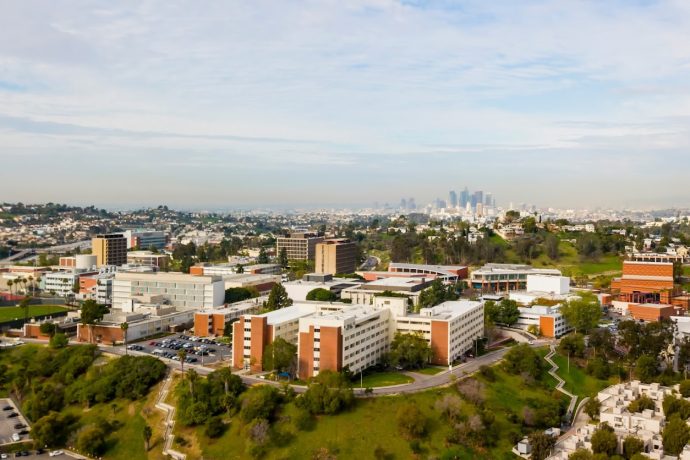- Think of challenges not as barriers but as invitations to invention.
- Launching new and innovative programs can feel risky, but any issues that arise with the program can be addressed and revised––but only if departments take the leap of launching the program in the first place.
- Build on what the department is already doing. See if there are ways to standardize practices so that faculty members are recognized and rewarded for their contributions.
- Know your students and their needs.
- Curriculum and culture are interrelated. Changes to one will affect the other in sometimes unexpected ways.
- The solution to a problem doesn’t always need to be as big as fully overhauling a major. A smaller intervention, when done thoughtfully and deliberately, can have an outsized impact.
California State University, Los Angeles Engaged English Requirement

The Engaged English requirement offered by the English department at ACLS Associate Member California State University, Los Angeles (Cal State LA) came about, as many innovations do, in response to a set of challenges. Those challenges included: concerns from administration about the cost of running community engagement opportunities for students through independent studies; related concerns about a lack of compensation for the time faculty were spending supporting and supervising students’ community engagement activities; and the fact that only a small subset of students were finding opportunities for community engagement before graduation.
The English department explored their options to respond to these challenges and concluded that integrating their community-engagement and pre-professional offerings into the curriculum through a three to four credit Engaged English requirement would codify and reward faculty participation, ensure that all students would receive community engagement experience before they graduated, and lower the department’s operating expenses. What was less anticipated was how it would precipitate a shift in the department’s identity. The resulting changes not only have affected students, but also faculty research, hiring, and even tenure and promotion policies.
Cal State LA’s English major is structured around 22 units of core courses that offer all students historical coverage in American, British, and World literatures; linguistics; theory; and college writing; students also take 21 units of more specialized elective courses. But in addition to these familiar requirements, students must take English Major Mentorship and Professionalization for one credit, plus two to three credits of additional Engaged English courses. The goal, according to Professor Linda Greenberg, who was chair during the creation of the requirement, is for the department’s majors to be not only students of English but practitioners of English.
Cal State LA is a teaching-intensive institution; many of the English department’s students are first generation college students and/or come from historically minoritized backgrounds. For those students and their families, questions of both future career and community impact are central, and the department designed their English Major Mentorship and Professionalization course to address them. Most students take this course at the end of their sophomore or beginning of their junior year, after they have completed many of their core requirements; students who transfer in from community colleges are encouraged to take it as soon as possible after matriculation. According to current Interim Chair Professor Kathryn Perry, students have reported that the course has helped them answer questions from their parents about why they’re majoring in English.
In addition to the course in mentorship and professionalization, students take another two to three units of Engaged English electives that allow them to move in directions that are of interest to them. Such electives include: Introduction to Archival Research; Introduction to Grant Writing as Community Engagement; and Introduction to Narrative Practices of Healing, among others. Students can also substitute working on the department’s WordsUncaged journal, which is a collaboration between Cal State LA students and men incarcerated at the nearby maximum security prison in Lancaster, or a different internship experience for academic credit. The department has a designated Faculty Internships Supervisor who conducts information sessions regularly for students and supervises students’ internship experiences.
In the course of creating the program, the department was careful to build upon its pre-existing strengths. The Engaged English requirement created opportunities for the department to professionally recognize teaching, research, and community engagement that faculty were already doing––and to expand the engaged aspect of the department’s identity through hiring practices. Greenberg notes that the department has emphasized community engagement in its most recent faculty searches and has hired candidates with a demonstrated commitment to public scholarship. They are also, as of this writing, in the process of revising their tenure and promotion guidelines to recognize community engagement as research, rather than service.
Currently, the department is revising its graduate program to include engagement as a core structuring principle, with a goal of launching the revised MA program in Fall 2025. The faculty would also like to deepen work on narrative practices of healing, which have proven critical to serving off-campus populations, such as those in the Lancaster prison. It would like to expand its range of community partners to include local refugee and undocumented populations and create more international opportunities for students through connections to universities abroad. Many of these efforts are already underway as of this writing.
In an age of falling enrollments in the humanities, CalState LA’s English program has held both steady and healthy, with around 400 English majors each year. The program is an example of how reimagining one element of a department’s curriculum can have a significant impact on both a department’s identity and its ability to serve its students. Rather than overhauling the entire major, they made a targeted, thoughtful intervention into their offerings that built on existing faculty interests and expertise, and in so doing, gave their students the tools needed to better understand the value of their own learning.

